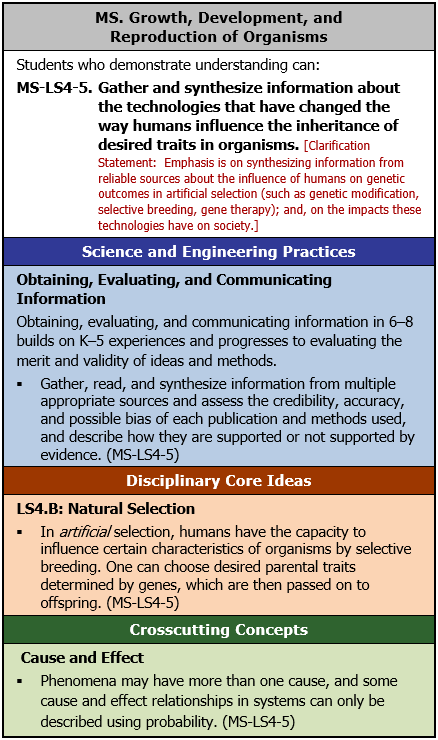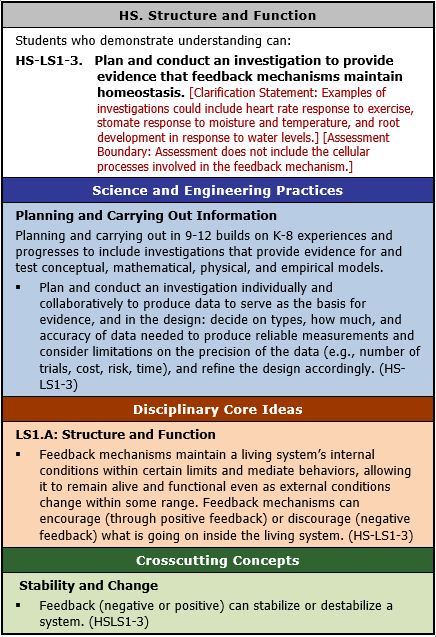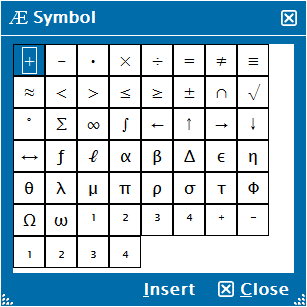Study Guide
Field 160: Biology
Recommendation for individuals using a screenreader: please set your punctuation settings to "most."
Review the special character palette available for science CSTs:
Sample Constructed-Response Item 1
Competency 0007
Pedagogical Content Knowledge
Use the following New York State P to 12 Science Learning Standard to complete the assignment below.
Using your pedagogical and content knowledge of biology, write a response of approximately 400 to 600 words in which you:
- identify a specific learning goal for the lesson;
- describe how you will assess student readiness for the lesson's learning goal;
- describe an appropriate and effective three-dimensional (i.e., disciplinary core idea, crosscutting concept, science or engineering practice) instructional strategy that you would use to help students meet the learning goal;
- explain how the instructional strategy you described will connect students' prior understanding (e.g., cultural relevancy, real-world experience) to the new knowledge related to the learning goal;
- describe a modification to the instruction that you would use and explain how it would address the strengths and/or needs of all students; and
- describe an appropriate and effective assessment related to the learning goal, in order to evaluate and promote learning and growth for all students.
Learning Standard
You are planning instruction for a middle school biology class. The lesson that you are preparing to teach will address the following standard from the New York State P to 12 Science Learning Standards.1

MS. Growth, Development, and Reproduction of Organisms
Students who demonstrate understanding can:
MS-LS4-5. Gather and synthesize information about the technologies that have changed the way humans influence the inheritance of desired traits in organisms. [Clarification Statement: Emphasis is on synthesizing information from reliable sources about the influence of humans on genetic outcomes in artificial selection (such as genetic modification, selective breeding, gene therapy); and, on the impacts these technologies have on society.]
Science and Engineering Practices
Obtaining, Evaluating, and Communicating Information
Obtaining, evaluating, and communicating information in 6 to 8 builds on K to 5 experiences and progresses to evaluating the merit and validity of ideas and methods.
- Gather, read, and synthesize information from multiple appropriate sources and assess the credibility, accuracy, and possible bias of each publication and methods used, and describe how they are supported or not supported by evidence. (MS-LS4-5)
Disciplinary Core Ideas
LS4.B: Natural Selection
- In artificial selection, humans have the capacity to influence certain characteristics of organisms by selective breeding. One can choose desired parental traits determined by genes, which are then passed on to offspring. (MS-LS4-5)
Crosscutting Concepts
Cause and Effect
- Phenomena may have more than one cause, and some cause and effect relationships in systems can only be described using probability. (MS-LS4-5)
Sample Strong Response to Constructed-Response Item 1
Learning Goal:
Students will gather and analyze information on the practice and results of using selective breeding on different dog breeds to create an explanation of inheritance.
Assessment of Student Readiness:
- Select examples of animals and plants that are appropriate to the student population and provide a brief scenario. Scenarios of animals and plants should include pictures and information of the wild varieties (origins) and the high diversity developed through artificial selection (e.g., apples, tomatoes, pigeons, chili peppers) as the descendants.
- Group students heterogeneously and provide each group with a scenario.
- Ask students in their groups to brainstorm which organismal characteristics (traits) are important and construct a model of their thinking as to how (cause) the modern varieties were developed (effect). Provide components and processes to include in the model, such as parents, offspring, desired traits, and time scale.
- Students analyze the visual data in the scenarios for traits and argue from evidence about the possible causes of the modern descendants.
- Students discuss and analyze the story of how the varieties of plants or animals in their scenario were developed.
- Students revise their group models to include the details that they learned from analysis and conclusions drawn from discussion.
Instructional Strategy:
Part 1
- Students are encouraged to bring in pictures of a dog and teacher provides additional pictures.
- Present the phenomenon of the high diversity of modern dogs through a short video that highlights artificial selection.
- Students sort dogs by traits to identify different breeds.
Part 2
- Each student selects a dog breed and researches the traits that are particular to that breed.
- Provide students with a rubric identifying items to include.
- Students make a brief report with traits particular to that breed.
Part 3
- Gallery walk: Students peer review other student readiness group's models and other students' breeds. Groups present their thinking as to how there is such diversity with regard to unique traits among current organisms.
- Facilitate discussion, including identifying examples in student models where parent organisms pass traits to offspring.
Connecting Prior Understanding:
This lesson is designed to connect the use of real-world technologies to changes in inheritance of desired traits and to do so in a culturally mindful context. Students will learn about the general process of artificial selection through researching the origins and modern varieties of plants and animals of relevance to them. The readiness assessment knowledge will be used as each student researches their dog breed.
Modification:
To help all students access their research projects, a teacher should make available reference materials and a list of approved websites about artificial selection, natural selection, and inheritance. This would ensure students have valid research materials to address a variety of reading levels, as well as access to current scientific articles.
Assessment:
Student understanding will be confirmed by the teacher asking questions throughout the lesson. For example, asking students during "student readiness" what they know of the organisms they are shown and how they use or encounter them in everyday life, or during "Part 3" to see what the current organisms on the gallery walk have in common with the organism of origin. Additionally, formative assessment will occur on the initial group models from "student readiness," and again as the groups add more information based on their research. The project of researching a dog breed will be assessed using a rubric to determine if students can identify beneficial traits of the breed, the cause of those unique breeds, and the role of artificial selection.
Sample Constructed-Response Item 2
Competency 0007
Pedagogical Content Knowledge
Use the following New York State P to 12 Science Learning Standard to complete the assignment below.
Using your pedagogical and content knowledge of biology, write a response of approximately 400 to 600 words in which you:
- identify a specific learning goal for the lesson;
- describe how you will assess student readiness for the lesson's learning goal;
- describe an appropriate and effective three-dimensional (i.e., disciplinary core idea, crosscutting concept, science or engineering practice) instructional strategy that you would use to help students meet the learning goal;
- explain how the instructional strategy you described will connect students' prior understanding (e.g., cultural relevancy, real-world experience) to the new knowledge related to the learning goal;
- describe a modification to the instruction that you would use and explain how it would address the strengths and/or needs of all students; and
- describe an appropriate and effective assessment related to the learning goal, in order to evaluate and promote learning and growth for all students.
Learning Standard
You are planning instruction for a high school biology class. The lesson that you are preparing to teach will address one aspect of the following standard from the New York State P to 12 Science Learning Standards.2

HS. Structure and Function
Students who demonstrate understanding can:
HS-LS1-3. Plan and conduct an investigation to provide evidence that feedback mechanisms maintain homeostasis. [Clarification Statement: Examples of investigations could include heart rate response to exercise, stomate response to moisture and temperature, and root development in response to water levels.] [Assessment Boundary: Assessment does not include the cellular processes involved in the feedback mechanism.]
Science and Engineering Practices
Planning and Carrying Out Information
Modeling in 9 to 12 builds on K to 8 experiences and progresses to using, synthesizing, and developing models to predict and show relationships among variables between systems and their components in the natural and designed worlds.
- Plan and conduct an investigation individually and collaboratively to produce data to serve as the basis for evidence, and in the design: decide on types, how much, and accuracy of data needed to produce reliable measurements and consider limitations on the precision of the data (e.g., number of trials, cost, risk, time), and refine the design accordingly. (HS-LS1-3)
Disciplinary Core Ideas
LS1.A: Structure and Function
- Feedback mechanisms maintain a living system's internal conditions within certain limits and mediate behaviors, allowing it to remain alive and functional even as external conditions change within some range. Feedback mechanisms can encourage (through positive feedback) or discourage (negative feedback) what is going on inside the living system. (HS-LS1-3)
Crosscutting Concepts
Stability and Change
- Feedback (negative or positive) can stabilize or destabilize a system. (HSLS1-3)
Sample Strong Response to Constructed-Response Item 2
Students will plan and conduct an investigation to collect and present data that provides evidence that during periods of different activity levels, the heart responds through a feedback mechanism that maintains homeostasis.
Present students with a video of marathoners crossing the finish line. Ask student pairs to identify physiological changes the body goes through when someone is running a marathon. Groups share out and describe changes.
Students' prior understanding of a heart rate response to activity levels and exercise in marathon athletes would be assessed. The concept of feedback mechanisms can be reinforced with a model illustrating the feedback loop phenomena (stimulus goes to receptor goes to heart (effector) goes to response) results in maintaining homeostasis. This model will enhance class discussion regarding the body's adaptive mechanisms to physiological feedback regarding changing external/internal conditions. Discussion outcomes will promote learning of disciplinary core ideas and crosscutting concepts.
Student groups plan and conduct investigations concerning the effects of activity on heart rate. Students should perform investigations using activities that reflect their interests (e.g., soccer, baseball).
Over multiple days, each group will collect evidence that reflects changing heart rates due to the level of activity over a 20-minute cycle. Each student in a group should do the same activity and measure their heart rate before and immediately after activity for several minutes. Consult with the groups to make sure that fair scientific tests are conducted and controls observed (e.g., how to measure dependent and independent variables).
Beginning with a resting heart rate, students will collect data so that they may present their findings on a graph. Groups must also provide a model illustrating the physiological feedback that is maintaining homeostasis. As students draw conclusions from their investigation, increased knowledge of feedback mechanisms should be evident in students' responses to questions such as:
How did heart rate respond to increased exercise and why?
Explain how the response to the stimulus of increased activity on heart rate is an example of positive or negative feedback.
How does a changing heart rate, in response to increased activity levels, impact another body system and maintain stability (homeostasis)?
Students' prior understanding from investigations in class will allow them to relate heart rate changes experienced during physical education classes or extracurricular activities. The investigations will further demonstrate heart rate changes as a body's response to internal or external conditions (e.g., exercise, injury, illness). Additional discussion questions can be introduced throughout student investigations to connect learning to real-world contexts or scientific claims (e.g., Why might professional athletes have very low resting heart rates?).
In the event physical exercise is not feasible, practical, or possible to carry out in this investigation, all students would benefit from utilizing heart rate computer simulation programs to conduct investigations. These programs would allow students to change a variable to regulate the simulation to achieve the learning goal. External conditions within the simulation can be manipulated to create a homeostatic response within a feedback system.
The teacher will informally assess students' understanding throughout the investigation via frequent check-ins. Each group's results from the investigation would also be assessed on the following criteria:
1. Presentation of data that includes data collection and findings displayed via a graphic model of heart rate over time.
2. The model illustrating the feedback mechanisms involved in the investigation.
3. Stated conclusions based on data/evidence collected in the investigation that support exercise increases heart rate or shows that a decrease in exercise slows heart rate as the result of a stimulus interacting with receptors.
4. Identify what they could do to refine the investigation to improve accuracy of data and reliable measurements.
Performance Characteristics for a Constructed-Response Item
The following characteristics guide the scoring of the response to a constructed-response item.
| Completeness | The degree to which the response addresses all parts of the assignment |
|---|---|
| Accuracy | The degree to which the response demonstrates the relevant knowledge and skills accurately and effectively |
| Depth of Support | The degree to which the response provides appropriate examples and details that demonstrate sound reasoning |
Score Scale for a Constructed-Response Item
A score will be assigned to the response to a constructed-response item according to the following score scale.
| Score Point | Score Point Description |
|---|---|
| 4 |
The "4" response reflects a thorough command of the relevant knowledge and skills:
|
| 3 |
The "3" response reflects a general command of the relevant knowledge and skills:
|
| 2 |
The "2" response reflects a partial command of the relevant knowledge and skills:
|
| 1 |
The "1" response reflects little or no command of the relevant knowledge and skills:
|
| U | The response is unscorable because it is unrelated to the assigned topic or off task, unreadable, written in a language other than English or contains an insufficient amount of original work to score. |
| B | No response. |
Acknowledgments
1From the New York State Education Department. New York State P-12 Science Learning Standards (2018). Internet. Available from http://www.p12.nysed.gov/ciai/mst/sci/documents/p-12-science-learning-standards.pdf; accessed 23 June 2018.

